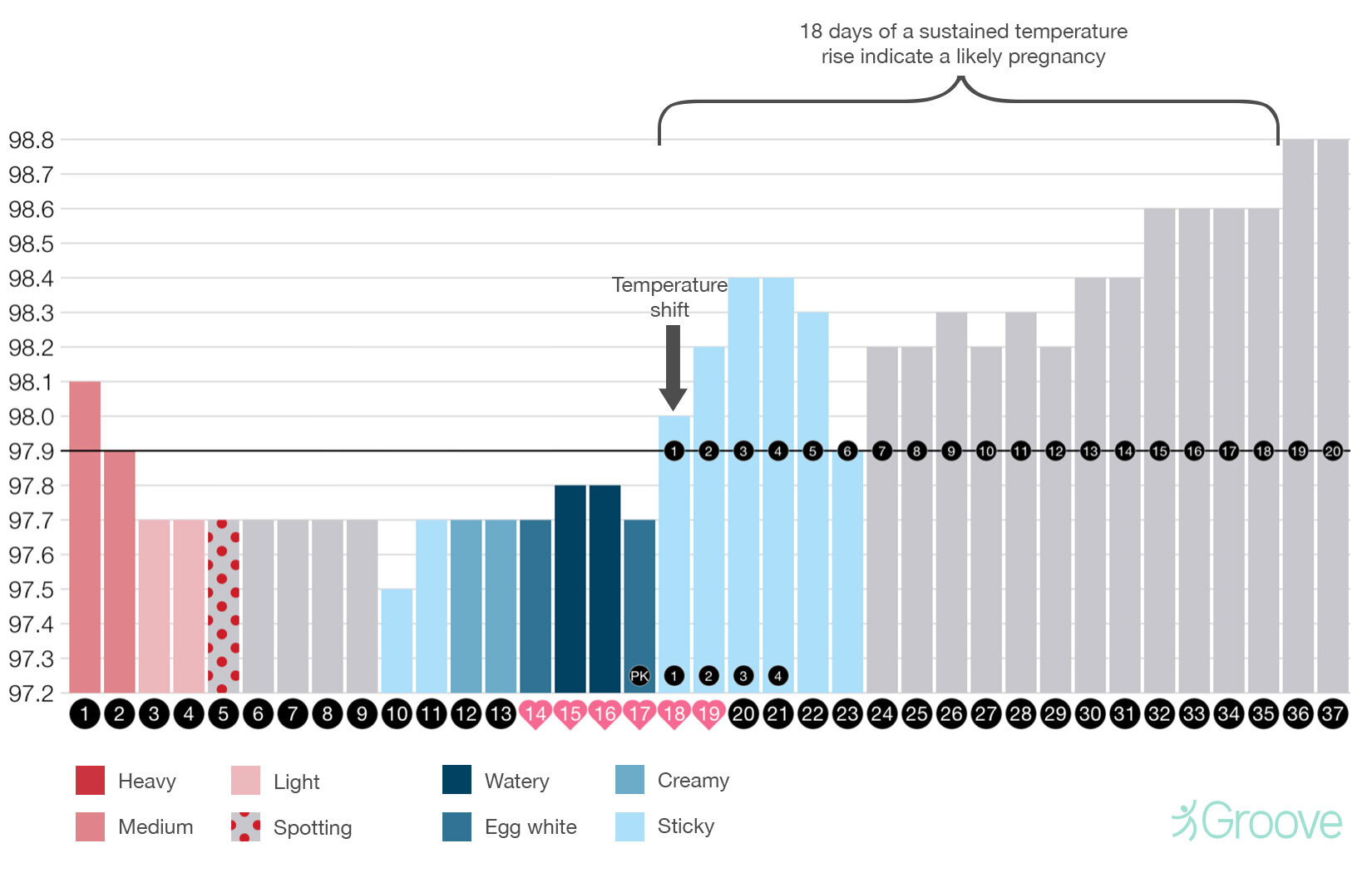LEARN
Period & Fertility Tracking
Maximize Your Chances of Getting Pregnant Using the Sympto-thermal Method of Fertility Awareness
This excerpt from The Cycle was written by Groove’s founder Jennifer Aldoretta
Using the sympto-thermal method of fertility awareness to get pregnant faster, in theory, is simply the opposite of using it for natural birth control.
If you know when you’re in your fertile window and you want to prevent pregnancy, all you have to do is avoid sex; if you want to get pregnant, you simply have to have sex during your fertile window, right? Well, yes and no.
Although there is about an 85% chance that a couple will get pregnant over the course of a year when using no method of contraception, there are days during the fertile window when sex is more likely to result in a pregnancy. Namely, any day during the fertile window when cervical fluid (cervical mucus) is slick and slippery, like raw egg white, will be extremely fertile. If spotting is present, even better!
The trick is to try to time intercourse as close to the day of ovulation as possible, which can feel like somewhat of a guessing game. However, if you compare the stress of using the sympto-thermal method to the stress of having no knowledge of the sympto-thermal method and trying to time sex based on an “average” menstrual cycle, it’s far less of a shot in the dark.
One must also take into account that a man’s sperm count will not be as high if he ejaculated the previous day. So to get pregnant, timing sex for days when cervical fluid (cervical mucus) is slick and slippery (meaning it has the highest water content) will result in the greatest chances of conception.
Not only is the sympto-thermal method great at taking much the guesswork out of becoming pregnant, it also essentially replaces the need to take a pregnancy test! Before I explain why, let’s talk biology (not too much, though).
As we learned in the section about sex hormones and the menstrual cycle, the corpus luteum secretes the hormone progesterone during the luteal phase in order to thicken and maintain the uterine lining. If the egg is, in fact, fertilized and implants into the uterus, it will secrete a hormone called human chorionic gonadotropin, or hCG.
This hCG tells the corpus luteum not to break down, as it typically would right before menstruation. So, rather than stopping progesterone production, the corpus luteum is given somewhat of a second wind, and continues progesterone production to maintain the uterine lining needed by the developing embryo.
Since progesterone is the hormone responsible for the rise in basal body temperature directly after ovulation, this continued production thanks to the implanted embryo causes basal body temperature to stay high. So by measuring basal body temperature, it’s easy to detect when you’re very likely pregnant. If your basal body temperature stays high for at least 18 consecutive days after the initial temperature shift, it is fairly safe to assume that you are pregnant [62].
It is common early on in a pregnancy to experience a triphasic basal body temperature pattern, or a basal body temperature that increases for a second time after the increase triggered by ovulation.
Sample pregnancy charts
This person experienced a slow-rise temperature shift on cycle day nine. After 18 days of a consecutively high basal body temperature, they can safely assume that they are pregnant. A triphasic pattern — or a basal body temperature that increases a second time, as seen starting on cycle day 20 — is often typical of someone who is, in fact, pregnant.
This person experienced a sudden temperature shift on cycle day 18. On cycle day 23, the temperature fell to the coverline, which can happen from time to time during the luteal phase. This individual also experienced a triphasic pattern, since their basal body temperature rose for a second time on cycle day 32. After 18 days of an elevated temperature, they can safely assume that they are pregnant.
Optimize your chances of getting and staying pregnant…
Our Period Reset course will start reversing even a lifetime of reproductive issues in just 30 days. Maximize your chances of a healthy pregnancy.
Love it, or get your money back!
Miscarriage
Unfortunately, a pregnancy resulting in a miscarriage is, sadly, sometimes part of the process — approximately 10-20 percent of known pregnancies end in miscarriage. It’s never an easy situation to encounter, especially when that pregnancy is dearly wanted. It is good to understand the warning signs, and please know that if you have suffered miscarriage, you are definitely not alone. Many women unfortunately suffer in silence, even though this experience is quite common.
If a pregnancy has been confirmed (or indirectly confirmed by 18 days of an elevated post-ovulatory basal body temperature) and basal body temperature begins to fall after that point, it may be an indication of an impending miscarriage [63]. See the sample chart below.
After 18 days of a sustained temperature rise — and after experiencing a triphasic basal body temperature pattern — this person's basal body temperature begins to fall significantly starting on cycle day 31. Unfortunately, this person experiences an early-stage miscarriage after a confirmed pregnancy on cycle day 33.
I would also recommend reading about using the sympto-thermal method to maintain or improve reproductive health for information on reproductive disorders that can lead to difficulty getting pregnant or carrying a pregnancy to term.
Groove now offers comprehensive mind-body-spirit wellness resources.
Learn Breath Work, find out what the heck Shadow Work is, and even get support healing your trauma.



